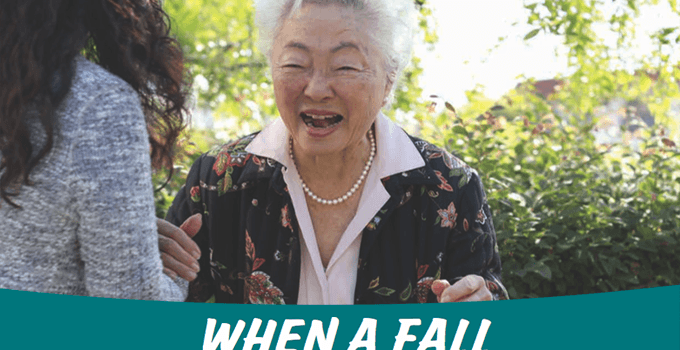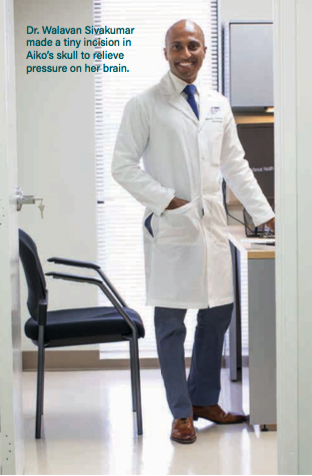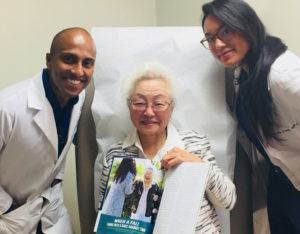

When a Fall Turns Into a Race Against Time
by Zara Jethani
Providence Little Company of Mary physicians work quickly to treat a neurological problem.
Adapted from article written by Alex Vejar | Photographed by Kristin Anderson
What started out as a normal night in Aiko Imagawa’s life quickly turned into a race against time. As Aiko puttered about her kitchen at late one night in August 2017, she slipped on the slick surface and ended up hitting her head on the floor. While she felt no ill effects in the immediate aftermath of the fall, Aiko would find herself in the emergency room later that day, ready to have an emergency craniotomy to remove the massive subdural hematoma she suffered as a result of the blow to her head.
“It never dawned on me that I had hit my head hard enough that it would burst any vessels in my head,” says Aiko, a retired registered nurse who was born in Hanford, CA in 1927. Soon after she fell, Aiko began feeling nauseated. Fearing she had suffered a concussion, she tried her best not to fall asleep. A few hours later, she decided to call her neighbor because she did not feel well. The neighbor decided to go over and check in on Aiko, only to discover that the elderly woman looked quite ill. When Aiko recounted her story, the neighbor insisted that she call Aiko’s family—her daughter Karen Kay and son-in-law Kean Oda.
When Kean arrived, he called 911. The ambulance took Aiko to Providence Little Company of Mary Medical Center Torrance, where she met Walavan Sivakumar, MD.
Dr. Sivakumar, a Los Angeles native and neurosurgeon at Pacific Neuroscience Institute located at Providence Little Company of Mary and Providence Saint John’s Health Center, said at first, Aiko seemed fine with the exception of being “bruised” from the fall. “She was coherent, aware of everything and able to tell us what happened,” Dr. Sivakumar explains. But within about 15 minutes of talking to Aiko, Dr. Sivakumar suspected something was seriously wrong. “As she was talking to us, she appeared to get sleepier, became more nauseous and even started vomiting,” says Dr. Sivakumar. “The sleepiness, confusion, nausea, and vomiting are signs of increased intracranial pressure.”
A CT scan confirmed what he feared: Aiko had suffered an acute subdural hematoma, a condition in which a blood clot underneath the brain’s leather-like covering puts pressure on the vital organ and causes the symptoms she was experiencing. The hematoma was greater than 1 centimeter large and causing 5 mm of midline shift to the brain. The hematoma appeared bright white on the CT scan—“meaning it was new blood,” Dr. Sivakumar says.

After Dr. Sivakumar and other doctors discussed the best course of action—including potentially not performing surgery—the decision was made to perform the craniotomy. As with any major surgery, there would be significant risks involved. “I was concerned because when someone who is 90 years old presents with an acute hematoma, the risks of surgery are higher,” says Dr. Sivakumar. He wasn’t the only person with concerns about the procedure. And in this case, it was possible that Aiko could die on the operating table.
“I know she was really scared,” Karen Kay says of her mother. “I think one of her biggest fears was that she would come out and not have all her faculties with her or be paralyzed or really have some more significant disability.”
The minimally invasive surgery took an hour and a half and consisted of Dr. Sivakumar using an operative microscope and keyhole instruments, which allowed him to work in a small corridor and access hard-to-reach areas, without exposing and possibly injuring large areas of brain. Since blood clots have the consistency of thick jell-o in the surface of the brain, Dr. Sivakumar proceeded to soften the clot by irrigating it with saline solution, which allowed it to be pulled away from the brain. He repeated this over and over until the pressure was relieved from Aiko’s brain.
When enough pressure is relieved in a patient where the brain injury has not reached an irreversible point, the surgeon begins to see the brain pulsating in rhythm with the patient’s heartbeat. That’s exactly what happened in Aiko’s case.
Aiko woke up soon after the surgery.
“The thing that surprised me was as soon as I woke up, and put my hand up on my head, I said, ‘Oh I’ve got all my hair,”’ Aiko remembers. “I thought he was going to have to shave my head.”

Aiko went through intense physical and occupational therapy during her recovery and has recently been cleared to return home. Karen Kay said that prior to the fall, Aiko lived alone and was healthy but now she will have a 24-hour caregiver and will need to use a walker for the foreseeable future. But other than those changes, Aiko feels mostly like her old self. She’s back to attending sporting events with her family and playing bridge with her friends.
It was during a recent return to her favorite card game that she realized she would be no worse for the wear. “When I held up those 13 cards in my hand and was able to figure out how to bid, I knew that things were OK, that I still had my grey matter,” Aiko happily says.
Karen Kay was pleasantly surprised at how rapidly her mother recovered from the surgery. “She recovered much faster than I thought she would for a 90-year-old,” Karen Kay says. “I’m really grateful and quite amazed at the recovery that she’s had.”
On the fateful night that started the ordeal, Aiko initially did not want her neighbor to tell her family as she felt she would recover quickly. But in hindsight, Aiko acknowledges just how lucky she was. She says if it hadn’t been for her neighbor, things could have transpired much differently. Aiko also credits Dr. Sivakumar, who she affectionately calls “Dr. Wally,” for performing the procedure. “I can’t say enough about the two people who really saved my life,” Aiko says. “My neighbor, who insisted that she call my family and Dr. Wally for having done what he did.”
The experience was difficult for Karen Kay. She says she could not have gotten through the experience without the support of her husband and help from her brother, who is a surgeon himself. Aiko says,“Having my daughter and son-in-law behind me, urging me on—that is a big, big help.”
For Dr. Sivakumar, performing a successful procedure like the one he did on Aiko is immensely rewarding. “This is why we do it. The family has their mother back.”
WHAT IS KEYHOLE CRANIOTOMY?
In neurosurgery, keyhole surgery is a concept of safely removing brain and skull base lesions—like tumors and blood—through smaller, more precise openings.
In the procedure, a surgeon uses advanced technology and instrumentation to make a small incision over a precise area of the patient’s skull, giving access to the brain. This approach also allows for minimal scarring.
When appropriate, a keyhole craniotomy is preferred to large craniotomies because it causes less collateral damage to the surrounding scalp, brain, blood vessels and nerves. Usually there is less pain and a faster recovery time.
While the keyhole craniotomy that Dr. Sivakumar used was for a subdural hematoma, it can be used to treat a host of brain conditions, including meningiomas, gliomas, metastatic brain or spine tumors, skull base tumors and several others.
Original article appears in the December 2017 issue of “In Good Company” published by Providence Little Company of Mary Medical Center Torrance.
About the Author

Zara Jethani
Zara is the marketing director at Pacific Neuroscience Institute. Her background is in molecular genetics research and healthcare marketing. In addition, she is a graphic designer with more than 20 years experience in the healthcare, education and entertainment industries.
Last updated: December 26th, 2017